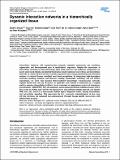Dynamic interaction networks in a hierarchically organized tissue
Author(s)
Kirouac, Daniel C.; Ito, Caryn; Csaszar, Elizabeth; Roch, Aline; Yu, Mei; Sykes, Edward A.; Bader, Gary D.; Zandstra, Peter W.; ... Show more Show less
Download44320_2010_Article_BFMSB201071.pdf (5.638Mb)
Publisher with Creative Commons License
Publisher with Creative Commons License
Creative Commons Attribution
Terms of use
Metadata
Show full item recordAbstract
Intercellular (between cell) communication networks maintain homeostasis and coordinate regenerative and developmental cues in multicellular organisms. Despite the importance of intercellular networks in stem cell biology, their rules, structure and molecular components are poorly understood. Herein, we describe the structure and dynamics of intercellular and intracellular networks in a stem cell derived, hierarchically organized tissue using experimental and theoretical analyses of cultured human umbilical cord blood progenitors. By integrating high‐throughput molecular profiling, database and literature mining, mechanistic modeling, and cell culture experiments, we show that secreted factor‐mediated intercellular communication networks regulate blood stem cell fate decisions. In particular, self‐renewal is modulated by a coupled positive–negative intercellular feedback circuit composed of megakaryocyte‐derived stimulatory growth factors (VEGF, PDGF, EGF, and serotonin) versus monocyte‐derived inhibitory factors (CCL3, CCL4, CXCL10, TGFB2, and TNFSF9). We reconstruct a stem cell intracellular network, and identify PI3K, Raf, Akt, and PLC as functionally distinct signal integration nodes, linking extracellular, and intracellular signaling. This represents the first systematic characterization of how stem cell fate decisions are regulated non‐autonomously through lineage‐specific interactions with differentiated progeny.
Date issued
2010-10-05Department
Massachusetts Institute of Technology. Department of Biological EngineeringJournal
Molecular Systems Biology
Publisher
Nature Publishing Group UK
Citation
Molecular Systems Biology (2010) 6: 417
Version: Final published version